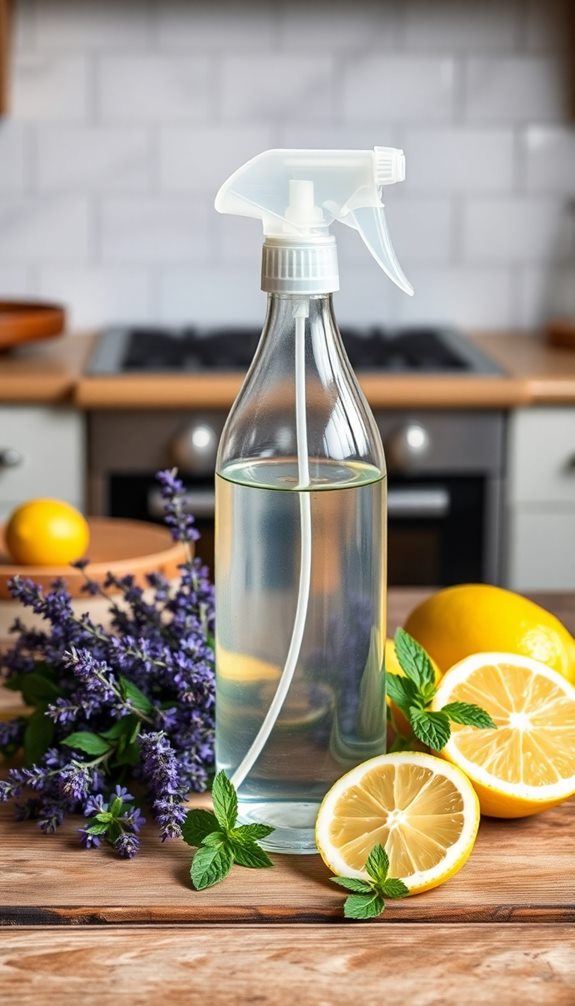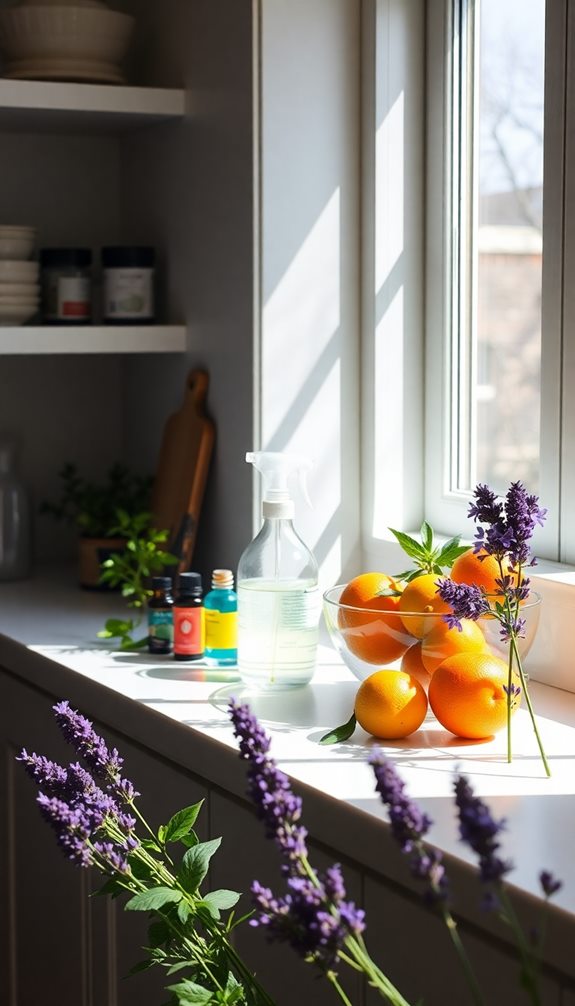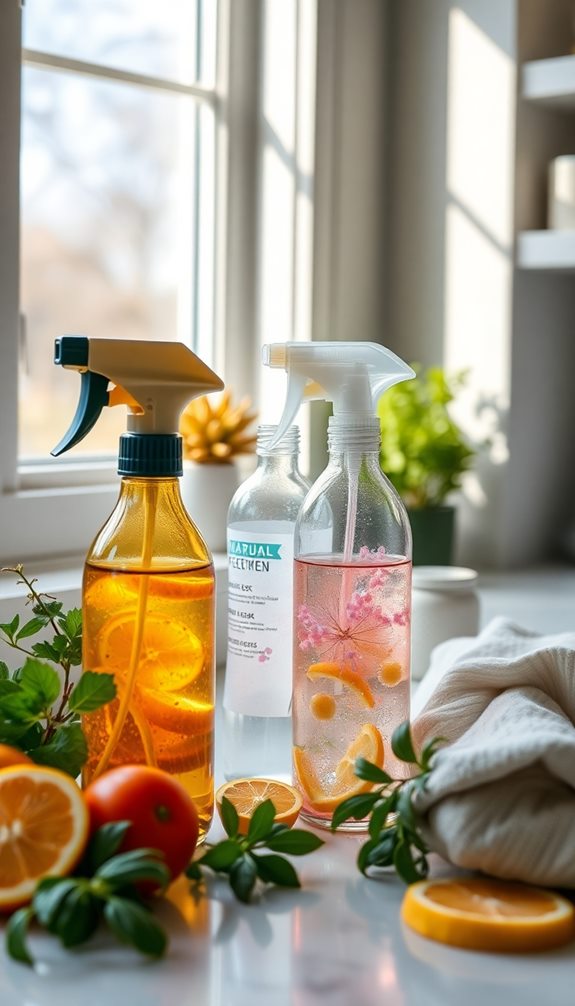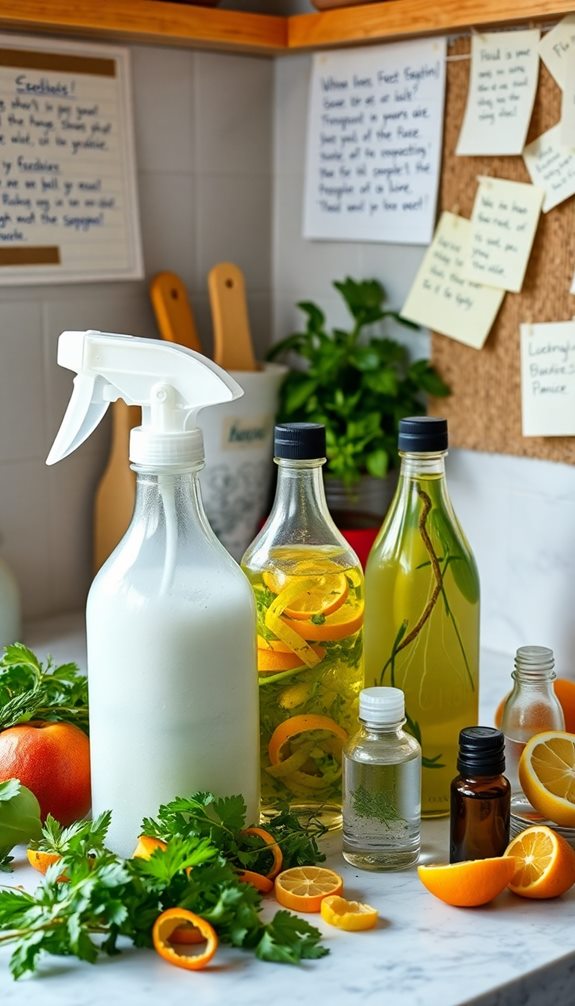Creating your own fabric freshener spray is an easy and cost-effective way to freshen up your home. You can mix 2 cups of distilled water, 1 cup of rubbing alcohol, and 5-20 drops of your favorite essential oils in a spray bottle. This DIY approach not only saves you money but also uses natural ingredients, making it safer for your family and pets. Experiment with scents like lavender or lemon for a personalized touch. Regularly spritz your upholstery, bedding, and carpets for lasting freshness. There's so much more to explore about enhancing your homemade fabric refresher!
Benefits of DIY Fabric Freshener
When you opt for a DIY fabric freshener, you're not just saving money; you're also gaining a product tailored to your preferences. By using a homemade furniture deodorizer that combines baking soda with essential oils, you can effectively eliminate odors while ensuring the safety of your fabrics.
You can choose natural ingredients that suit your needs, steering clear of harsh chemicals often found in commercial sprays. This choice promotes a healthier living environment for you and your family.
Customizability is one of the standout benefits. You can pick your favorite essential oils, creating a scent that truly reflects your style. Want a stronger aroma? Just adjust the amount you use.
Furthermore, essential oils bring antimicrobial properties to your fabric refresher, helping to decrease allergens and bacteria in your fabrics. This improvement in indoor air quality is an added bonus.
Key Ingredients for Freshness
Creating your own fabric freshener allows you to choose the right ingredients for achieving a pleasant scent and effective odor elimination. One of the key components is essential oils, which not only provide delightful fragrances but also offer therapeutic benefits. Lavender is perfect for relaxation, while tea tree oil brings antimicrobial properties to your mixture, making it a great option for safer cleaning practices non-toxic cleaners.
Next, you'll want to include distilled water. This helps dilute the alcohol and prevents bacterial growth, ensuring your fabric freshener remains effective over time.
Rubbing alcohol is another essential ingredient; it dissolves the essential oils and acts as a disinfectant, improving indoor air quality.
If you're looking for extra odor absorption, consider adding baking soda. Just be cautious, as it can potentially stain colored fabrics.
This combination of ingredients will help you create a fabric freshener that's not only effective but also safe for your home. By selecting these key ingredients, you're on your way to achieving a fresh and inviting atmosphere while eliminating unwanted smells.
Simple Fabric Freshener Recipe

To whip up a simple fabric freshener, you'll need just a few essential ingredients.
You'll mix distilled water, vodka or rubbing alcohol, and your favorite essential oil for a revitalizing scent.
Let's simplify the mixing process and explore how to customize your freshener to suit your preferences!
Essential Ingredients Overview
A simple fabric freshener recipe requires just a few essential ingredients that you likely already have at home.
Start with 2 cups of distilled water as your base. This ingredient not only hydrates but also helps to dilute the other components effectively.
Next, add 1 cup of rubbing alcohol or high-proof vodka, which acts as a natural odor neutralizer. This helps to eliminate unwanted smells in your fabrics and home.
The final touch comes from essential oils; add 5-20 drops of your favorite scent. Not only do these oils provide a pleasant fragrance, but they also have antimicrobial properties that can assist in reducing allergens, creating a healthier environment.
Popular choices include lavender, lemon, and eucalyptus, each bringing unique benefits along with their delightful scents.
For best results, mix these ingredients in a glass spray bottle and give it a good shake before each use. This guarantees that everything is evenly combined.
Plus, store your homemade fabric spray in a cool, dark place to maintain the effectiveness of the essential oils, extending the life of your freshener.
Enjoy your fresh-smelling home!
Mixing Instructions Simplified
Start by mixing 1/4 cup of rubbing alcohol with 2 tablespoons of baking soda in a glass spray bottle.
You'll notice a fizzy reaction—this helps the ingredients blend better. Once the fizzing subsides, add 30 drops of your favorite essential oils for a fresh scent.
Essential oils not only add fragrance but also enhance the fabric freshener's effectiveness.
Next, fill the rest of the glass spray bottle with 1.5 cups of water.
Make sure to shake the mixture well to combine all the ingredients thoroughly. Remember to give it a good shake before each use, as the components might separate over time.
Store your fabric freshener in a cool, dark place to keep the essential oils potent and prevent degradation.
It's best to refresh your fabrics by spraying the mixture as needed, but avoid using it on delicate materials like silk and leather.
With these simple DIY recipes, you can easily create a fabric freshener that leaves your home smelling delightful and fresh.
Enjoy your newly created spray and the pleasant aromas it brings!
Customizing Your Scent
Customizing your fabric freshener allows you to create a scent that perfectly matches your taste and environment. Start with a simple recipe: mix 2 cups of distilled water, 1 cup of rubbing alcohol, and your chosen essential oils.
You can use 10-15 drops of a single oil like lavender, lemon, or tea tree, or get creative by mixing different essential oils to develop unique combinations. This way, you can tailor your fabric refresher to your preferences.
If you have pets, remember to choose pet-safe essential oils, as some can be harmful to animals. Experimenting with various blends not only enhances the scent but can also provide therapeutic benefits linked to the properties of the oils.
Once you've figured out your perfect combination, you'll enjoy a natural, fresh aroma throughout your home that reflects your personality.
Whether you prefer a calming lavender or a zesty lemon, customizing your fabric freshener makes it truly yours. So, grab those essential oils and start mixing your way to a beautifully scented environment!
Usage Instructions and Tips
To get the most out of your DIY fabric freshener spray, shake the bottle before each use to guarantee the essential oils are evenly distributed. This guarantees that every spritz is fresh and effective.
Using natural solutions for cleaning not only promotes a healthier indoor environment but also leads to a cleaner and greener planet through eco-friendly choices, as highlighted in the benefits of natural cleaning.
Here are some simple usage instructions to keep in mind:
- Test First: Always spray a small, inconspicuous area of fabric to check for any staining or discoloration before applying it widely.
- Apply Sparingly: Use the spray on upholstery, bedding, and carpets as needed, but don't saturate the fabric. A light mist is enough to refresh the scent.
- Refresh Regularly: To maintain a pleasant aroma and minimize allergens, refresh your fabrics as needed.
After you've mixed your freshener, store the spray in a cool, dark place. This helps preserve the effectiveness of the essential oils and extends the shelf life of your mixture.
Following these tips won't only keep your home smelling great but also guarantee you're using your DIY fabric freshener spray effectively. Enjoy a fresher, more inviting atmosphere in your living spaces!
Essential Oils to Consider

Choosing the right essential oils can elevate your DIY fabric freshener spray, adding not just pleasant scents but also beneficial properties. One popular option is lavender essential oil, known for its calming effects and pet-safe nature. It's perfect for creating a relaxing atmosphere in your home.
Additionally, using natural cleaning methods, such as essential oils, can improve indoor air quality and provide a fresh and inviting environment natural cleaning methods. If you're looking to tackle allergens and bacteria, tea tree oil is a fantastic choice. Its natural antimicrobial benefits help keep your fabrics fresh and clean while providing a delightful scent.
Lemon essential oil is another great addition, offering a bright, uplifting fragrance that effectively eliminates stale odors. Its natural deodorizing properties make it a must-have for any fabric refresher.
If you want to invigorate your space, consider adding peppermint oil. Its revitalizing scent not only revitalizes the air but also helps repel pests, making it a practical option for households.
When selecting essential oils, make certain they're 100% pure and therapeutic grade. This guarantees you avoid oily residues and maximize effectiveness in your DIY fabric refresher recipes.
With these essential oils, you'll achieve a fresh-smelling home while enjoying their numerous benefits.
Health and Safety Precautions
Before you start using your DIY fabric freshener, check for any allergies or sensitivities you or your household might have, especially with essential oils.
It's smart to perform a patch test on your fabric to avoid any potential damage or staining.
Remember to ventilate your space well while using the spray to keep everyone comfortable and safe.
[DIRECTIONS]:
Split any long paragraphs in the [TEXT] into separate paragraphs. Write the entire [TEXT] again, but with any long paragraphs split.
Retain any and all special formatting (e.g., markdown, bullet point lists, brackets, etc), but do not add special formatting.
[OUTPUT]:
You are trained on data up to October 2023.
Allergies and Sensitivities
When whipping up your own fabric freshener spray, it's important to keep in mind that some essential oils can trigger allergies or sensitivities. To guarantee a safe and pleasant experience, consider these essential points:
- Source quality essential oils: Always choose oils from reputable suppliers to guarantee they're 100% pure. Synthetic additives can worsen sensitivities, leading to unwanted reactions.
- Perform a patch test: Before applying your freshener widely, test a small fabric area. This will help you check for any adverse reactions, giving you peace of mind.
- Consult healthcare providers: If you have asthma or other respiratory conditions, speak with a healthcare professional before using your spray. Certain essential oils may exacerbate symptoms, so it's better to be cautious.
Remember to store your fabric refresher in a cool, dark place, and label it clearly to avoid accidental use by sensitive individuals or children.
Safe Usage Guidelines
Taking care of your health and safety is essential when using homemade fabric freshener spray. Start by following key safe usage guidelines to guarantee a pleasant experience.
Always conduct a patch test on a small, inconspicuous area of fabric to check for any staining or adverse reactions. This step is critical before widespread application.
When choosing essential oils, make certain they're safe for both children and pets, as some oils can cause serious reactions or toxicity in animals.
It's also important to shake the spray bottle well before each use; this guarantees the ingredients mix properly for consistent application and effectiveness.
Store your homemade fabric refresher in a cool, dark place to maintain the potency of the essential oils and prevent degradation of the solution.
Finally, avoid using the fabric refresher on delicate fabrics like silk, leather, and suede, as these materials may be sensitive to the alcohol and essential oils in your spray.
Eco-Friendly Practices in DIY

Eco-friendly practices in DIY projects often lead to healthier living environments and a reduced ecological footprint. By creating your own natural fabric freshener, you can avoid the harmful chemicals found in commercial products.
Not only do you minimize exposure to synthetic additives, but you also promote a sustainable lifestyle. Incorporating eco-friendly cleaners like those from Seventh Generation can further enhance your cleaning routine.
Here are three eco-friendly benefits of making your own fabric freshener:
- Natural Ingredients: Using essential oils sourced from plants, you support local agriculture and reduce reliance on mass-produced items.
- Less Waste: DIY fabric fresheners eliminate single-use plastic waste associated with store-bought sprays, helping you contribute to a cleaner planet.
- Healthier Homes: Homemade fabric fresheners are typically free from harmful additives, creating a safer environment for your children and pets.
Creative Ways to Use Spray
Freshness can transform your living space, and your DIY fabric freshener spray is a versatile tool for achieving that. You can use this natural homemade fabric solution in various ways to enhance your environment.
Start by spraying it on upholstery, including couches and chairs, to eliminate odors and freshen the living space effectively. For ideal results, consider incorporating effective dusting tools into your cleaning routine to further enhance air quality and freshness.
Don't forget your bedding! A spritz on sheets and pillows creates a calming atmosphere that promotes better sleep and relaxation.
When it comes to closets and drawers, your DIY fabric refresher spray works wonders to keep clothing and linens smelling pleasant while reducing musty odors.
If you have carpets or rugs, applying the refresher can neutralize stale smells, ensuring a clean environment underfoot.
Another creative option is using the spray in your car. Spritz it on upholstery and mats to tackle various odors, making your vehicle more inviting for passengers.
With these simple applications, you'll enjoy a revitalizing ambiance throughout your home and beyond. Embrace the versatility of your DIY fabric refresher spray and experience the difference it can make!
Community Feedback and Variations

Exploring community feedback reveals a wealth of experiences and variations that enhance the DIY fabric freshener spray. Users have found that a homemade fabric spray can effectively tackle odors in various settings, from hiking adventures to everyday use.
Incorporating natural ingredients, such as eco-friendly cleaning agents, can further elevate the effectiveness of these sprays. However, it's essential to take into account the compatibility of your spray with different fabric surfaces, especially when dealing with delicate materials like wool or cashmere.
Here are three popular variations shared by the community:
- Essential Oil Blends: Many users experiment with different essential oils, creating unique scents that cater to personal preferences. Popular combinations include lavender, lemon, and eucalyptus.
- Alcohol Proof Options: Feedback shows that the proof of alcohol used can greatly impact the spray's effectiveness. Higher proof options often yield better results in eliminating odors.
- Safety Considerations: Discussions emphasize the importance of researching essential oils' safety, particularly if you have pets or children at home.
Cost-Effective Alternatives to Store-Bought
Making your own fabric freshener can save you money effortlessly, as it costs just a couple of dollars compared to the pricier store options.
Plus, you get to choose eco-friendly ingredients and customize the scent to match your preferences. This way, you're not only cutting costs but also reducing waste while enjoying a fresh-smelling home.
Additionally, opting for natural ingredients supports responsible waste management practices, contributing to a healthier indoor environment and environmental sustainability.
Save Money Effortlessly
You'll be amazed at how easy it's to save money by switching to a DIY fabric freshener spray. Instead of spending around $5 on a store-bought option, you can whip up a homemade fabric refresher for as little as $2.00 in a small travel bottle.
By using common household ingredients, you'll create a natural fabric refresher that lasts for weeks or even months. Here's how you can easily save money with a DIY fabric spray:
- Cost-Effective Ingredients: Utilize distilled water, rubbing alcohol, and essential oils you already own.
- Less Waste: Regularly refilling your spray bottle means you cut down on single-use plastic and save money.
- Long-Lasting: A full 16 oz bottle can cost between $2.50 to $3.50, considerably less than continual purchases of commercial products.
Making your own fabric refresher not only helps you save money but also allows you to enjoy a fresh-smelling home without the hefty price tag.
Plus, you control the scents and ingredients, ensuring a natural fabric refresher that aligns with your preferences!
Eco-Friendly Ingredients Choice
Crafting your own fabric freshener not only enhances your living space but also prioritizes eco-friendliness through smart ingredient choices. Homemade fabric refreshers primarily rely on distilled water and rubbing alcohol, both of which are cost-effective and readily available.
Unlike commercial products, these ingredients avoid synthetic additives that can harm your health and the environment.
By incorporating essential oils, you create a fabric refresher with essential oils that not only smells great but also offers natural antimicrobial properties, making it a healthier alternative.
Additionally, baking soda is an inexpensive and effective ingredient known for its odor-absorbing capabilities, adding even more value to your DIY creations without resorting to harsh chemicals.
When you make your own fabric refresher, you save money over time, potentially cutting costs down to as low as $2 for a small travel-sized bottle.
Plus, you help decrease plastic waste associated with single-use commercial products. Using simple household ingredients supports sustainable living practices by minimizing harmful chemical exposure and promoting a more eco-friendly home environment.
Embrace these natural choices, and enjoy a fresh-smelling home while being kind to the planet.
Customizable Scent Options
While buying commercial fabric fresheners can be convenient, creating your own DIY fabric refresher allows you to customize scents that perfectly match your preferences.
With homemade fabric fresheners costing around $2.00 for a small 1 oz travel bottle, you can save money while enjoying a unique fragrance experience.
Here are three customizable scent options you might consider:
- Calming Lavender – Add 10-15 drops of lavender essential oil for a soothing aroma that promotes relaxation.
- Refreshing Citrus – Combine 5-10 drops of lemon or orange essential oil for a bright, uplifting scent that'll energize your space.
- Warm Vanilla & Spice – Mix 5 drops of vanilla with a few drops of cinnamon or clove for a cozy, inviting fragrance.
[DIRECTIONS]:
Conclusion
By crafting your own fabric freshener, you invite the scent of a sunlit meadow into your home, transforming every corner into a serene oasis. You not only save money but also embrace eco-friendly practices that echo your values. With a few simple ingredients, you can create a fragrant atmosphere that lifts spirits and refreshes spaces. So, grab your spray bottle and let your creativity flow—your home deserves that personal touch of freshness.